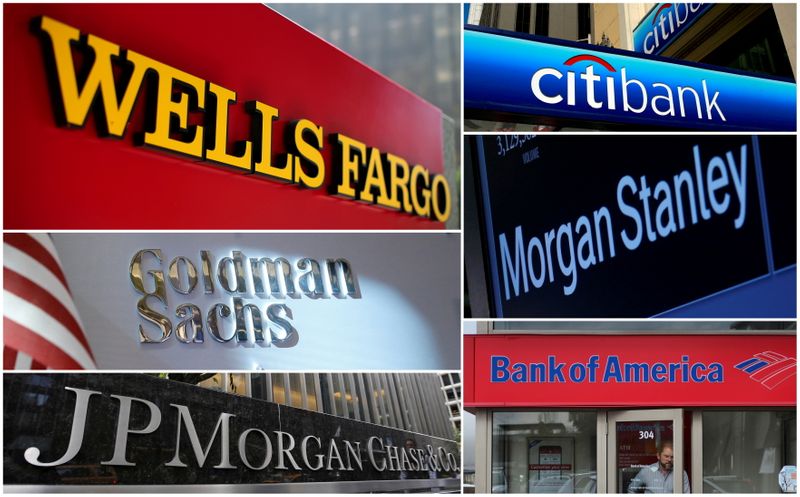By David Henry and Pete Schroeder
WASHINGTON (Reuters) -The country's largest lenders are poised to start issuing as much as $130 billion in dividends and stock buybacks from next month after the U.S. Federal Reserve gives them what is expected to be a clean bill of health on Thursday, said analysts.
The Fed on Thursday will release the results of its "stress tests," an annual health check introduced in the wake of the 2009 financial crisis to see how banks would fare in an extreme hypothetical economic downturn.
Due to pandemic lockdowns, lenders last year weathered a real-life economic crash that was by many measures more extreme than the Fed's imaginary scenario. The downturn prompted the regulator to issue emergency regulatory relief, curb bank capital distributions, and conduct two additional stress tests in 2020.
Thanks to those measures, plus low interest rates and government stimulus that held off loan losses, analysts expect the country's largest lenders to perform well on Thursday, leading the Fed to lift remaining capital distribution curbs.
"The banks entered the crisis well-capitalized, played an important role in the economic response, and now appear set to reward their shareholders with meaningful capital returns," said Isaac Boltansky, director of policy research at Compass Point Research & Trading.
LIFTING CURBS
The Fed imposed additional limits on bank capital distributions in June 2020 after a COVID-19 "sensitivity analysis" showed overall loan losses at 34 large banks could reach $700 billion, with some lenders falling below minimum required capital levels.
After banks performed well during another stress test in December, the Fed allowed them to resume buying back stock in addition to paying dividends capped at the bank's annual net income.
In March, the central bank said that it expected to lift remaining curbs for “most firms” after its stress tests in June provided banks were above regulatory minimum capital levels.
Broadly speaking, this year's test is more severe than the 2020 scenario the Fed devised prior to the pandemic, which envisioned unemployment peaking at 10%, but is less severe than December's test which put that figure at 12.5%. For 2021, the hypothetical unemployment rate peaks at 10.75%.
The KBW Bank Index is up about 25% this year compared with a 13% gain in the S&P 500 index, driven in part by expectations banks will pass easily.
"This is one of the positive catalysts that bank investors are looking for this year," said David Long, a Raymond James analyst.
The Fed rules allow lenders to adjust their buybacks and dividends quarterly. Since April, big lenders have issued more than $40 billion in debt to help finance what some analysts expect to be record payouts.
"The numbers are big," wrote Glenn Schorr, an Evercore ISI analyst. By his estimates the six biggest banks will spend, on average, 122% of earnings on buybacks and dividends in the 12 months beginning July, more than double the ratio of the previous period.
Those six - Bank of America Corp (NYSE:BAC), Citigroup Inc (NYSE:C), Goldman Sachs Group Inc (NYSE:GS), JPMorgan Chase & Co (NYSE:JPM) Morgan Stanley (NYSE:MS) and Wells Fargo (NYSE:WFC) & Co together will increase payouts by $66 billion to $130 billion in the next four quarters, according to Schorr's estimates.
The banks and the Fed declined to comment.
WELLS WINNER?
Wells Fargo, which has built up capital more rapidly than rivals due in part to a Fed-imposed cap on its balance sheet, is expected to post the biggest jump in payouts - spending an additional $19 billion over the next 12 months by Schorr's estimates.
All told, the country's fourth-largest lender could pay out 167% of earnings compared with just 28% during the previous 12 months, according to Schorr's estimates.
While the bumper paydays will please shareholders, they are likely to draw ire from Democrats in Washington, who want banks to use their cash to help everyday Americans.
"Pressure going forward will be on how to make the ... test tougher," wrote Jaret Seiberg, an analyst at Cowen Washington Research Group.
